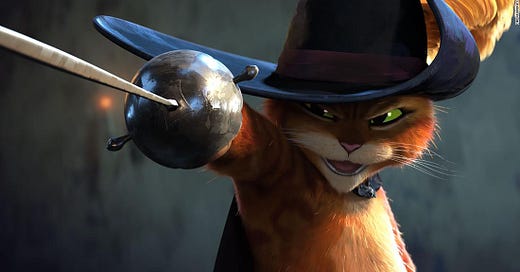Today, I was lucky enough to watch the latest Puss in Boots film with several close friends. We thought it would be a fun excuse for us to get together, eat junk food, and spend time together; we did not anticipate crying by the end of the movie.
The movie follows Puss in Boots as he journeys with companions Perrito, a quixotic holy fool with a heart of gold, and Kitty Softpaws, a heartbroken cynic and former flame of Puss in Boots. The goal? To reach a fallen star with the powere to grant one’s any wish before their antagonists. The biggest threat, and most interesting villain is Death, represented anthropomorphically by a whistling, fear-inducing wolf wiedling akimbo sickles. Death has it out for Puss in Boots who treats life with wanton disregard, disrespect, and ingratitude. In his quest to the fallen star, Puss overcomes his vainity, comes to appreciate the company of his companions, romantic and platonic, and courageously accepts the inevitability of his death while embracing the meaning, happiness, and beauty of his one life.
I understood the conclusion of the movie in economic terms. No, I mean it! Hear me out: instead of wishing for his nine lives, Puss in Boots realizes that life is granted meaning by its finitude, i.e., when you only have one life to live, you can’t afford not to do your very best to live it well. In economics jargon, Puss in Boots: The Last Wish illustrates the concept of diminishing marginal utility. Just like with all other goods, services, and things of value, the more one has of something, the less valuable each additional unit thereof. The first or, in Puss in Boot’s case, the last life you have to live is the most valuable, most significant, and most enriching. The hard budget constraint of time alive encourages us to spend this invaluable resource well.




